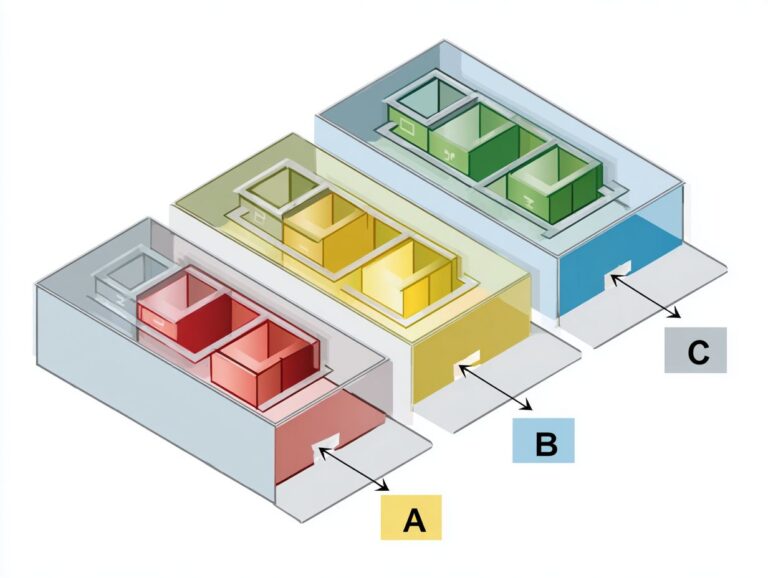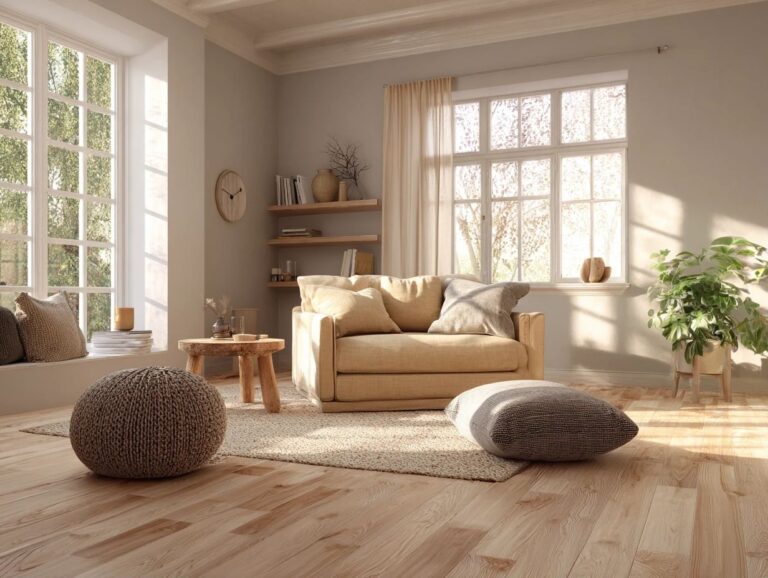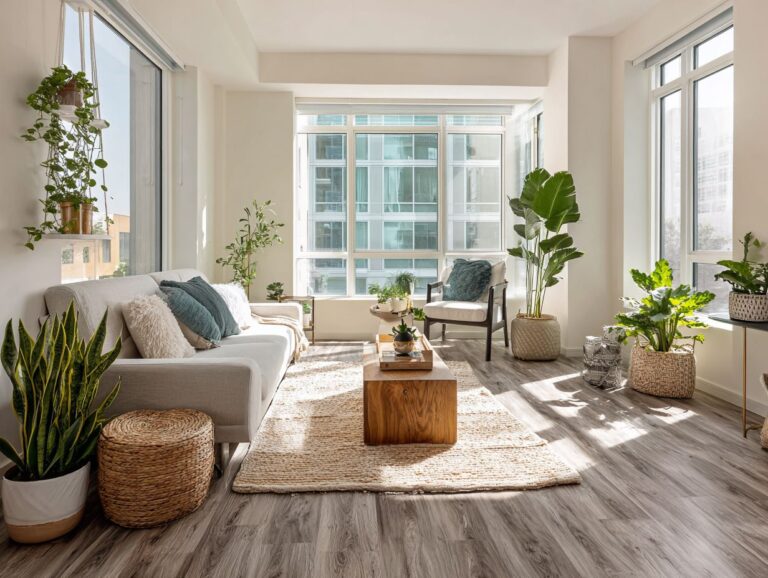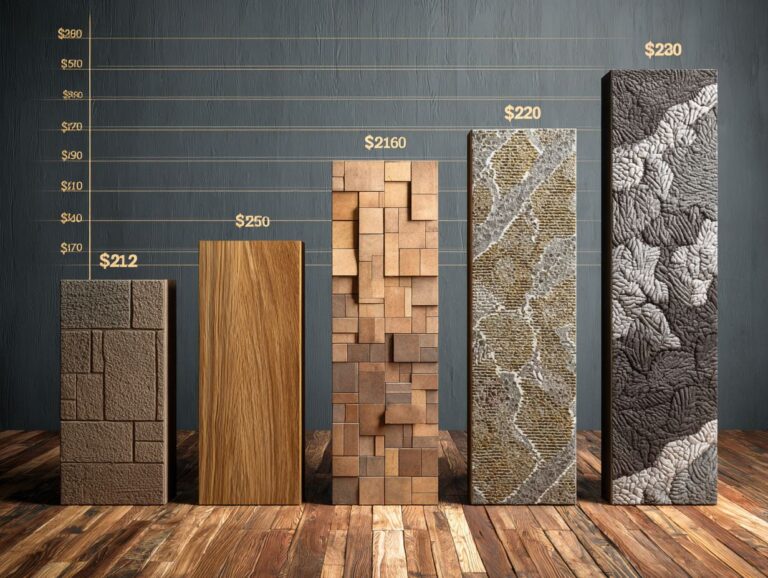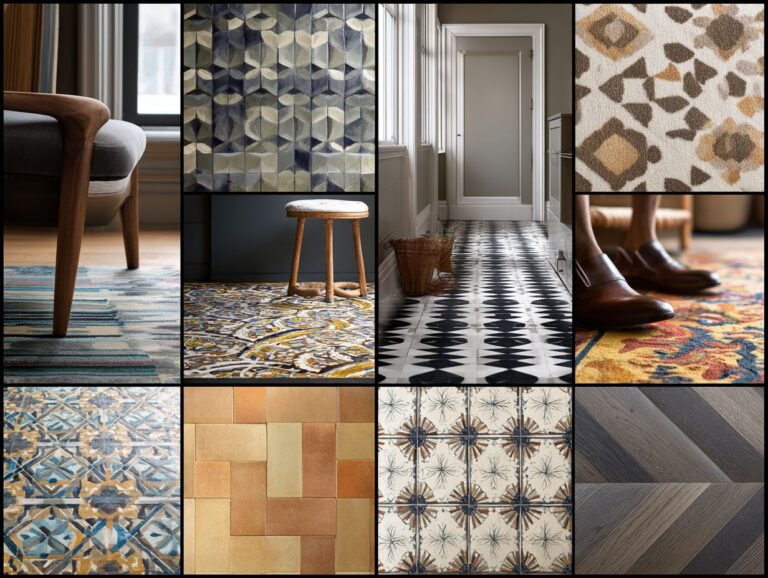Flooring Lifespan by Material – Replacement Cycles
When planning a home renovation, knowing how long different flooring materials last can save you time and money. Whether you’re considering hardwood floors, laminate flooring, or tile flooring, each option comes with its own replacement cycle and maintenance needs. In this article, we’ll look at how long different flooring options last, so you can choose wisely for your next project and make sure your investment lasts.
Key Takeaways:
Contents
Importance of Understanding Lifespan
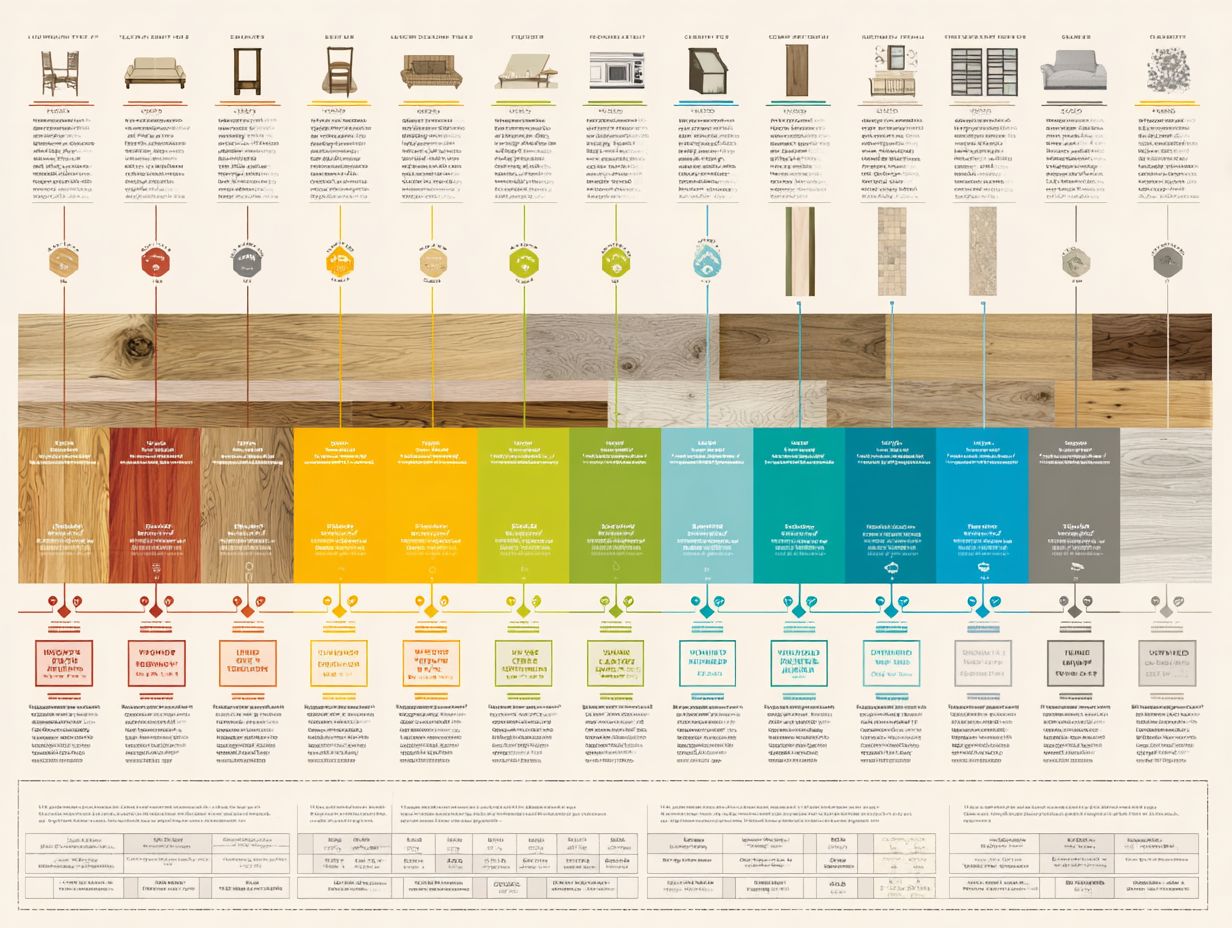
Knowing the lifespan of flooring materials helps homeowners budget for replacement, ensuring they choose the right options for their needs.
For example, hardwood floors can last between 30 and 100 years if they are taken care of properly, making them a long-lasting option. Carpet often needs replacing every 5 to 15 years, based on its quality and foot traffic.
Knowing these timelines helps with budgeting: if you’re choosing hardwood, plan for refinishing expenses, while carpet might need periodic replacement.
Tools like the National Wood Flooring Association’s maintenance guide can help you make decisions about floor care, ensuring you are happy with your flooring for a long time.
Factors Influencing Flooring Lifespan
The lifespan of flooring materials depends on how well they are installed and maintained.
For example, hardwood floors can last over 50 years with proper care, while neglect may reduce their lifespan to 20 years or less. If you are considering flooring options for high-traffic areas, understanding the balance between durability and cost is crucial. Our guide on the best flooring for rental properties offers insights into making the right choice.
Key maintenance practices include:
- Regular sweeping
- Using appropriate cleaners
- Applying sealants every few years
Environmental conditions are important; high foot traffic causes more wear, so think about using area rugs where people walk often. Humidity levels can cause material warping, so maintain indoor humidity between 30-50%.
Getting it installed by an expert enhances its appearance and durability, making it a wise decision.
Flooring Material Lifespan Statistics
Flooring Material Lifespan Statistics
Lifespan by Flooring Material: Vinyl Flooring
The Flooring Material Lifespan Statistics give information about how long and how well different vinyl flooring types last, focusing on vinyl sheet and vinyl plank Knowing how long these items last helps people decide about expenses, upkeep, and how often they need to be replaced.
Lifespan by Flooring Material focuses on two types of vinyl flooring:
- Vinyl Sheet Flooring: This type of flooring has an average lifespan of 20 years. Its durability is influenced by factors such as the quality of the material, the level of foot traffic, and maintenance practices. Vinyl sheets resist water and are easy to clean, so they work well in places where spills and moisture are common, like kitchens and bathrooms.
- Vinyl Plank Flooring: With an average lifespan of 25 years, vinyl planks tend to last longer than sheets, partly due to their thicker composition and interlocking installation, which provides added stability. Vinyl planks often mimic the appearance of hardwood, offering a more aesthetically pleasing option while maintaining vinyl’s durability and ease of maintenance.
The data highlights the need to select the correct type of vinyl for certain uses. Vinyl planks offer a longer lifespan and are ideal for areas where aesthetics and longevity are a priority. In contrast, vinyl sheets are affordable and work well, making them a good option for areas with a lot of moisture.
Choosing between vinyl sheet and vinyl plank flooring depends on your budget, how you want it to look, and how much foot traffic it will get. When considering these factors and how long the flooring will last, people can choose options that are both useful and look good.
Types of Flooring Materials
Each type of flooring has its own pros and cons that impact how long it lasts, how you care for it, and where it works best. For those managing rental properties, understanding the balance between durability and cost is crucial, as discussed in our article on the best flooring options for rental properties.
Hardwood Flooring
Hardwood flooring, particularly popular choices like oak and maple, boasts a lifespan of 20-100 years, depending on maintenance and installation.
To keep your hardwood floors strong and long-lasting, clean them regularly. Start by sweeping or vacuuming weekly to remove dirt and grit.
To maintain the floor’s appearance, every month, clean it using a damp mop and a suitable cleaner for hardwood. Consider applying a protective layer every two years to avoid scratches. Avoid excessive moisture, as it can warp the wood; place mats near entryways and use humidity controls if necessary.
These practices keep the flooring in good condition and looking nice over time.
Laminate Flooring
Laminate flooring, known for its affordability and ease of installation, generally lasts 10-30 years with proper maintenance.
To make your laminate flooring last longer, follow some simple steps.
- Regular sweeping or vacuuming helps eliminate dirt and debris, while occasional damp mopping with a mild cleaner prevents buildup.
- Put felt pads under furniture legs to prevent scratches.
- Consider using area rugs in high-traffic zones for extra protection.
- If you live in a humid area, using a dehumidifier can minimize moisture that could warp the planks.
By following these steps, your flooring will look good and work well for many years.
Vinyl Flooring
Vinyl flooring is very resistant to water, which makes it a great choice for places with a lot of moisture. It can last between 10 to 20 years.
Its affordability often makes it a favorite among homeowners, priced between $2 to $5 per square foot.
Regular maintenance helps it last longer: simply sweep or vacuum weekly to remove dirt, and mop with a gentle cleaner monthly.
For high-traffic areas, using furniture pads can prevent wear. Dealing with spills quickly also helps maintain its appearance while ensuring that the flooring remains comfortable underfoot.
By following these practices, you can keep your vinyl flooring looking new for years.
Tile Flooring
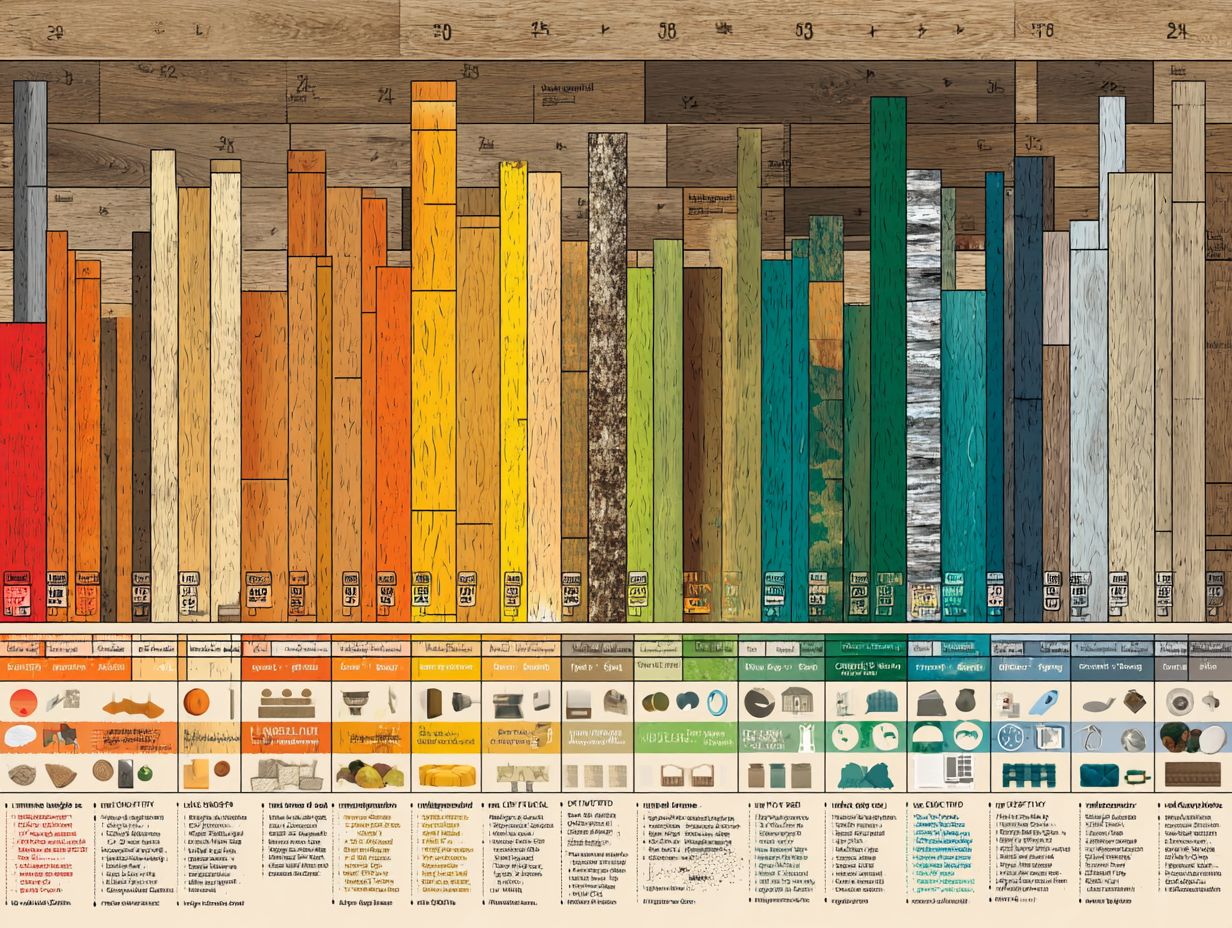
Tile flooring is celebrated for its durability and water resistance, often lasting 20-50 years with proper care.
To maintain the longevity of tile, focus on three essential maintenance practices.
- First, regularly sweep or vacuum to remove dirt and debris, preventing scratches.
- Next, mop with a pH-neutral cleaner monthly to avoid buildup and maintain shine.
- Look at the grout lines for cracks or color fading; put on a grout sealer every one to three years to protect against water damage.
For stubborn stains, consider a steam cleaner, which effectively cleans without harmful chemicals, enhancing both the appearance and lifespan of your tile flooring.
Carpet Flooring
Carpet flooring typically lasts 5-15 years, heavily influenced by the type of fibers used and regular cleaning habits.
Nylon carpets are known for their durability, often reaching the upper end of this lifespan when well-maintained. To make your carpet last longer, regularly clean it with a vacuum that has a HEPA filter to effectively remove dirt.
Consider deep cleaning every 6-12 months with steam cleaning or by hiring a professional. Avoid harsh chemicals that can degrade fibers. Place mats at entrances to reduce wear from foot traffic, which can drastically improve longevity.
Bamboo Flooring
Bamboo flooring is a sustainable choice that can last 20-25 years, offering a unique aesthetic while being eco-friendly.
To maximize its lifespan, proper care is essential.
- Start by regularly sweeping or vacuuming to remove dust and debris, which can scratch the surface.
- Use a damp mop with a pH-neutral cleaner specifically designed for hardwood or bamboo; avoid harsh chemicals that can degrade the finish.
- Place rugs in high-traffic areas and felt pads under furniture legs to prevent dents.
- Maintain a stable indoor humidity level between 30-50% to prevent the bamboo from expanding or contracting, ensuring your floors look beautiful for years to come.
Replacement Cycles by Material
Knowing how often different flooring materials need to be replaced can help homeowners plan their renovation projects better.
Hardwood Flooring Replacement Cycle
Hardwood floors typically need replacing every 20-100 years, based on their upkeep and refinishing.
Regular care is necessary to extend the life of your hardwood floors.
Look for signs of wear such as scratches, dullness, or gaps between boards. If you notice these issues, consider refinishing before replacement.
Using high-quality sealants and cleaners, like Bona Hardwood Floor Cleaner, can also help maintain their sheen. For deep scratches, sanding and refinishing may be required, while minor scratches can often be treated with wood fillers.
Placing area rugs in busy areas can reduce wear, keeping your hardwood floors beautiful and lasting longer.
Laminate Flooring Replacement Cycle
Laminate flooring typically lasts between 10 to 30 years, based on how much it’s walked on and how well it’s cared for.
To make your laminate flooring last longer, clean it regularly. Sweep or vacuum daily to remove dust and debris, and mop weekly with a damp cloth using a laminate-specific cleaner.
Avoid excessive water, which can lead to warping. Placing mats at entryways minimizes dirt tracked in, reducing wear.
Be mindful of furniture placement, using pads underneath legs to prevent scratches. Check for damage like bending or deep scratches and fix them quickly to prevent more problems.
Vinyl Flooring Replacement Cycle
Vinyl flooring replacement cycles usually range from 10-20 years, influenced by exposure to moisture and heavy foot traffic.
To evaluate the need for replacement, start by inspecting for signs of wear, such as tears, discoloration, or curling edges.
If you see scratches that remain after cleaning, try using a thorough cleaning with a product such as Bona Vinyl Floor Cleaner.
For effective maintenance, regularly sweep or vacuum to remove debris, and use a damp mop for spills.
Apply felt pads under furniture to reduce scratches and avoid harsh chemicals that can degrade the material.
These strategies can significantly prolong your vinyl flooring’s lifespan.
Tile Flooring Replacement Cycle
Tile flooring can last 20-50 years, but may require replacement sooner if installation quality is poor or if tiles are damaged.
To check the condition of your tile flooring, begin by carefully looking for any cracks or chips, as these might show structural problems. Check for uneven tiles or grout that has deteriorated, as these can lead to moisture problems.
Use a level to identify any irregularities. If you see a lot of damage or ongoing wetness, it’s a good idea to hire an expert. They offer solutions, including fixes and full replacements, depending on how bad the problem is. Typically, if damage exceeds 30% of the floor, replacement is recommended.
Carpet Flooring Replacement Cycle
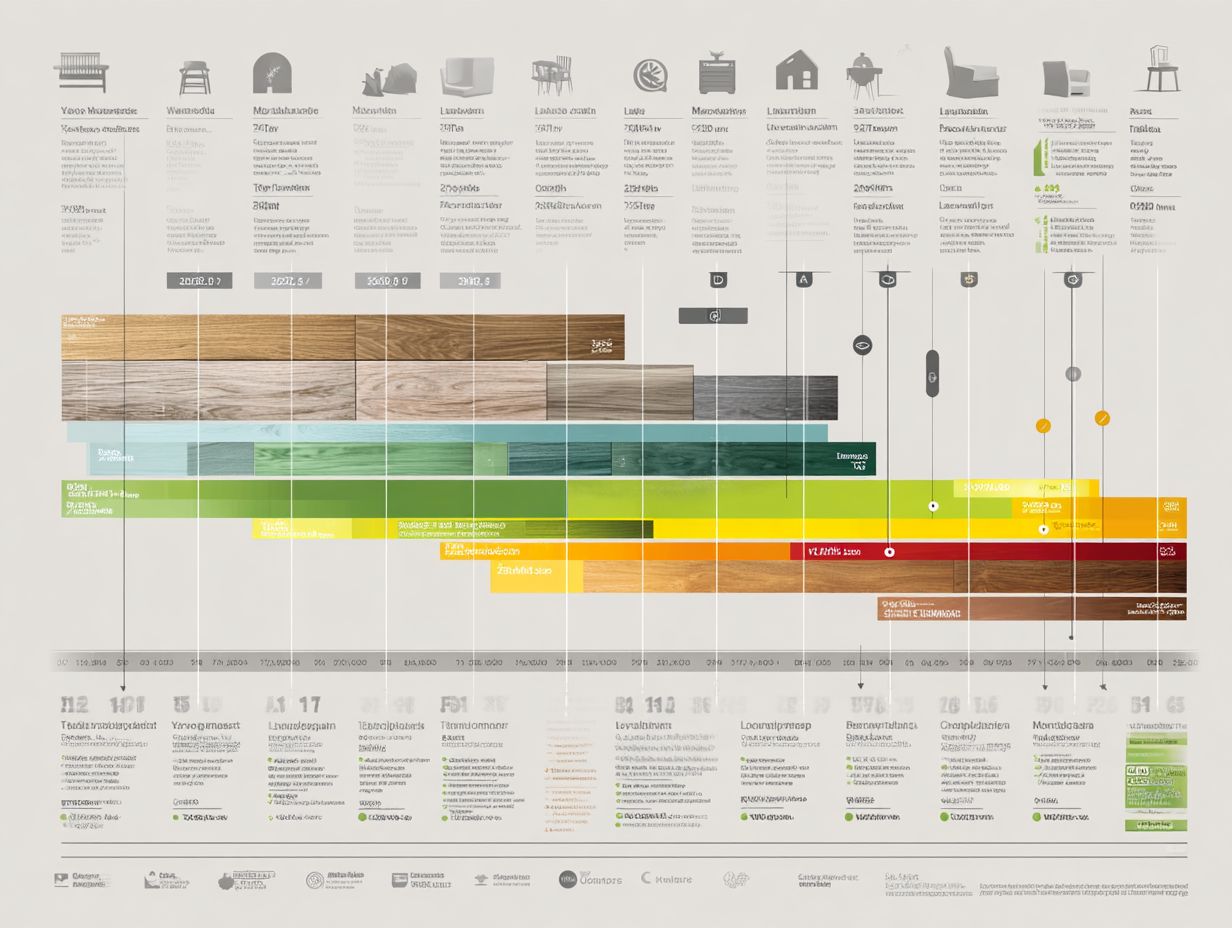
Carpet flooring usually needs replacing every 5 to 15 years, depending on how often it’s cleaned and the kind of material.
Regular cleaning significantly extends your carpet’s lifespan. For instance, vacuuming at least once a week helps remove dirt and debris that can wear down fibers.
Steam cleaning needs to be done every 12-18 months to get rid of tough stains and allergens. Consider using high-quality carpet cleaning machines, such as the Bissell ProHeat or Hoover Power Scrub, which effectively remove dirt and stains compared to traditional methods.
If your carpet shows signs of heavy matting or discoloration despite regular cleaning, it may be time to consider a replacement.
Bamboo Flooring Replacement Cycle
Bamboo flooring typically has a replacement cycle of approximately 20-25 years, influenced by its maintenance and use.
To extend the lifespan of bamboo flooring, implement regular cleaning and avoid harsh chemicals.
Use a microfiber mop weekly to remove dust and debris, and a pH-neutral cleaner monthly. Consider applying a sealant every three to five years to protect against scratches and water damage.
If you notice deep scratches, sanding can restore the surface but should be done cautiously-no more than two to three times over the floor’s lifetime. If signs of wear become prominent despite maintenance, it may be time to consider replacement.
Signs It’s Time to Replace Flooring
Knowing when to replace flooring can prevent expensive repairs and improve safety for homeowners.
Visible Wear and Tear
Visible wear and tear, such as scratches, dents, or discoloration, is a primary indicator that flooring needs replacement.
Beyond surface damage, consider how your flooring feels underfoot. If you notice noticeable softness or springiness, it’s a sign that the subfloor may be compromised.
To assess damage more quantitatively, check for gaps wider than a quarter inch between planks, as this indicates serious structural issues. Use a moisture meter to determine if humidity levels exceed 12%, which can lead to mold growth.
If you encounter multiple issues, consulting with a flooring professional can help you decide whether replacement is necessary or if repairs will suffice.
Maintenance Challenges
Challenges in maintaining flooring, especially with high foot traffic, can lead to premature replacement needs.
To effectively extend the life of your flooring, consider implementing regular maintenance routines.
Vacuuming daily removes dirt that can scratch surfaces, while mopping with a pH-neutral cleaner once a week can maintain shine.
Using furniture pads can protect hardwood or laminate from scratches. Pay attention to signs such as buckling or deep scratches, which may indicate it’s time for a replacement.
In cases where refinishing is possible, like with hardwood, this can rejuvenate the space for a fraction of the cost of new flooring.
Health Concerns
Health concerns, like allergies or mold exposure, can necessitate flooring replacement, particularly in damp environments.
Mold and dust mites thrive in certain flooring materials, such as carpets and rugs, which can trap allergens. If you have ongoing allergy symptoms, particularly in rooms with thick carpets, think about switching to hard surfaces like laminate or vinyl.
These materials are easier to clean and less likely to retain allergens. Regular maintenance also plays a role; for instance, vacuuming carpets weekly and using a dehumidifier can mitigate allergens until replacement is feasible.
Monitoring humidity levels and ensuring adequate ventilation can also help reduce allergen buildup.
Cost Considerations for Replacement
The price plays a big role in deciding which flooring to use and how much money to allocate for renovations. Understanding the financial impact of different materials can be crucial, as explored in our analysis of flooring ROI by material.
Budgeting for Replacement
Creating a solid budget for flooring replacement involves considering material costs, installation fees, and potential long-term savings.
To start, gather estimates for your preferred flooring options. For example, hardwood can range from $5 to $10 per square foot, while vinyl might be between $2 to $7.
Installation typically adds another $3 to $7 per square foot. To save money, consider DIY installation for simple types like laminate, which you can lay down for about $1 per square foot.
Look for sales at local home improvement stores or online marketplaces such as Wayfair to find cost-effective solutions. Choose something that lasts, ensuring you get your money’s worth for a long time.
Long-Term Value of Different Materials
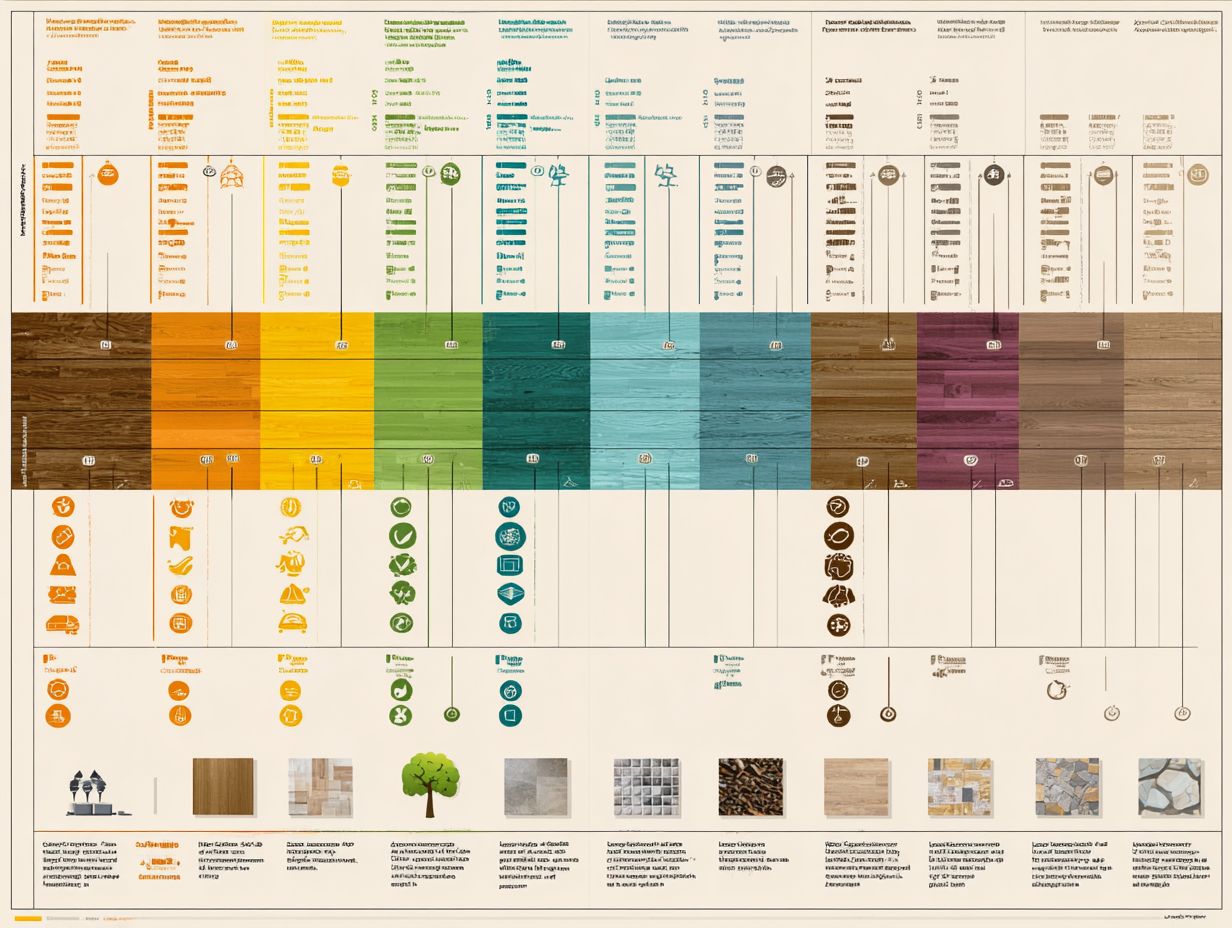
Assessing the long-term value of flooring materials helps homeowners make informed choices that balance initial costs with durability.
Consider hardwood, laminate, and vinyl.
Hardwood costs between $8 and $15 per square foot initially, but with proper care, it can last for many years, making it a good choice.
Conversely, laminate is more affordable at $1-$5 but typically lasts 15-25 years, offering lower long-term value.
Vinyl can vary from $2-$7 and boasts water resistance with a lifespan of about 10-20 years.
Evaluating these factors against your lifestyle-such as household traffic and moisture exposure-can guide you to the best choice that fits both your budget and durability needs.
Frequently Asked Questions
What is the average lifespan of hardwood flooring?
The average lifespan of hardwood flooring is approximately 25 years. However, this can change based on things like upkeep, amount of use, and the kind of wood used.
How long does laminate flooring typically last?
Laminate flooring typically has a lifespan of 10-20 years, depending on the quality and thickness of the flooring. It can last longer with proper maintenance and minimal foot traffic.
What is the expected replacement cycle for vinyl flooring?
The expected replacement cycle for vinyl flooring is around 15-20 years. With advances in technology, vinyl flooring can now have a longer lifespan and may only need to be replaced after 20-25 years.
How often should carpet flooring be replaced?
Typically, carpet flooring lasts 5 to 15 years before it needs replacing. This can vary depending on the quality of the carpet and the amount of foot traffic it receives.
What is the lifespan of bamboo flooring?
Bamboo flooring can last anywhere from 20-25 years with proper maintenance and minimal foot traffic. It is known for its durability and can often last longer than other types of wood flooring.
What is the replacement cycle for tile flooring?
Tile flooring can last a lifetime with proper maintenance and care. If tiles crack or break, replace them quickly to prevent safety risks or more damage to the floor.
